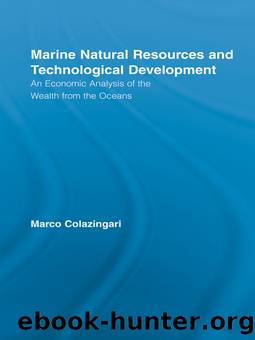Marine Natural Resources and Technological Development by Marco Colazingari

Author:Marco Colazingari [Colazingari, Marco]
Language: eng
Format: epub
Tags: Social Science, Sociology, General, Political Science, Public Policy, Environmental Policy, Nature, Natural Resources, Science, Earth Sciences, Oceanography
ISBN: 9781135196196
Google: le6ydo6mXrIC
Publisher: Routledge
Published: 2013-01-11T05:45:33+00:00
Polymetallic manganese nodules are the result of a slow accumulation process of oxides of manganese and iron and of hydroxides. It has been calculated that they grow by 3 mm per million years (MA), their age having been estimated at 2â8 MA (ISA 2001a). Even though polymetallic nodules contain more than thirty metallic elements, traces of nearly all the elements in the periodic chart can be found. However, they are primarily valued for their manganese, nickel, copper and cobalt content. Nodules contain up to 30 percent of dry weight of manganese (average about 20 percent), up to 17 percent of iron (average about 12.5 percent) and less than 3 percent combined of nickel, copper, lead, zinc and cobalt. Water contained in nodules is about 80 percent of the total mass.
Although nodulesâ shape vary from nearly flat to spheroidal, ranging in size from 1 to 15 cm in diameter,10 nodules usually appear as potato-sized spherical concentrations of layered metallic substances lying on the seabed partially buried by sediments. Larger nodules (5â20 cm) are mainly grown by diagenetic process and are rich in manganese, nickel and copper but relatively poor in cobalt. Nodules originated by hydrogenic process are usually smaller (2â4 cm) and of irregular shape, rich in cobalt but poor in other elements. Although first discovered more than 200 years ago in the Siberian Kara Sea (Artic Ocean), it was since the R/V HMS Challenger expedition between 1872 and 1876 that scientists begun to study them extensively. Commercial interest in nodules awakened in the 1960s and 1970s, when huge nodules deposits were discovered and the potential economic value of their strategic minerals content highlighted.
In spite of the well-known origin, mineralogy and composition of the nodules, assessments of their resource potential are not well documented. The currently known distribution of nodules on the ocean bottom is based on information acquired by side scan SONAR, drill cores, freefall grab samples, seafloor photos, video camera records and direct observation from HOVs. Estimates of nodulesâ total volume vary from the 1965 optimistic figure of 1.5 trillion metric tons (mt) calculated by John Mero (Glasby 2002) to the more realistic figure of about 500 billion mt, of which only 15 to 25 billion mt satisfy current mining criteria11 (ISA 2001a). An economic criterion to evaluate nodules deposits is to combine their abundance with their metal content. Glasby (2000) calculated that the combined content of nickel, copper and cobalt must be greater than 2.5 percent and the abundance of nodules on the seafloor must be greater than 10 kg per square meter. However, other assessments with this same criterion have been made, resulting in different figures.
All oceans have their own deposits of polymetallic manganese nodules, their distribution density and their metal content and proportion varying greatly according to the host location. Nodule deposits have been found at many depths, however, the highest concentrations lie in the vast plains of the deep seafloor between 4,000 and 6,000 meters depth. The majority of nodules of economic interest occur in the Eastern Pacific Ocean equatorial region, the so-called Clarion-Clipperton Fracture Zone (CCFZ).
Download
This site does not store any files on its server. We only index and link to content provided by other sites. Please contact the content providers to delete copyright contents if any and email us, we'll remove relevant links or contents immediately.
The Lonely City by Olivia Laing(4568)
Animal Frequency by Melissa Alvarez(4150)
All Creatures Great and Small by James Herriot(3986)
Walking by Henry David Thoreau(3681)
Exit West by Mohsin Hamid(3634)
Origin Story: A Big History of Everything by David Christian(3472)
COSMOS by Carl Sagan(3346)
How to Read Water: Clues and Patterns from Puddles to the Sea (Natural Navigation) by Tristan Gooley(3239)
Hedgerow by John Wright(3106)
How to Do Nothing by Jenny Odell(3101)
The Inner Life of Animals by Peter Wohlleben(3099)
How to Read Nature by Tristan Gooley(3077)
Project Animal Farm: An Accidental Journey into the Secret World of Farming and the Truth About Our Food by Sonia Faruqi(3018)
Origin Story by David Christian(2991)
Water by Ian Miller(2950)
A Forest Journey by John Perlin(2915)
The Plant Messiah by Carlos Magdalena(2745)
A Wilder Time by William E. Glassley(2689)
Forests: A Very Short Introduction by Jaboury Ghazoul(2671)
